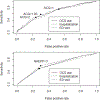Comparing Asthma Control Questionnaire (ACQ) and National Asthma Education and Prevention Program (NAEPP) asthma control criteria
- PMID: 30213611
- PMCID: PMC6309658
- DOI: 10.1016/j.anai.2018.09.448
Comparing Asthma Control Questionnaire (ACQ) and National Asthma Education and Prevention Program (NAEPP) asthma control criteria
Abstract
Background: Adequate assessment of control is critical to asthma management. The Asthma Control Questionnaire (ACQ) and the National Asthma Education and Prevention Program (NAEPP) criteria are commonly used measures of asthma control.
Objective: To examine the associations between the ACQ and NAEPP criteria and compare the validity in association with lung function, asthma exacerbation, and quality of life.
Methods: The ACQ and the NAEPP criteria were administered to 373 adolescents with asthma aged 12 to 20 years. The 2 measures correlated with forced expiratory volume in 1 second (FEV1), asthma exacerbation (oral corticosteroid use, hospitalization, and emergency department [ED] use) in the past 12 months, and quality of life.
Results: Agreement between the ACQ and NAEPP criteria was moderate (κ = 0.40-0.61). Neither of the 2 measures was a reliable predictor of FEV1 less than 80% because of the high rate of false-positive results for the ACQ (68%) and low sensitivity for the NAEPP (49%). The NAEPP identified more cases of uncontrolled asthma (84.6%) than the ACQ (64.6%). The ACQ was a significant predictor of recent oral corticosteroid use, hospitalization, and ED visits (area under the curve = 0.66, 0.66, and 0.64, respectively; P < .001), as was NAEPP (area under the curve = 0.63, 0.66, and 0.61, respectively; P < .001). Both measures were significantly associated with quality of life, and the associations were particularly strong for the ACQ (r = -0.87 for symptom subscale, r = -0.76 for activity subscale, and r = -0.78 for emotional function subscale).
Conclusion: Neither the ACQ nor the NAEPP appears to reliably predict lung function, whereas both measures reasonably associate with acute asthma exacerbation. The ACQ may be the superior measure in gauging the psychosocial effect of asthma control given its particularly strong associations with quality of life.
Trial registration: ClinicalTrials.gov Identifier: NCT02293499.
Copyright © 2018 Elsevier Ltd. All rights reserved.
Conflict of interest statement
Conflict of Interest: none
Figures




Similar articles
-
Effect of oral magnesium supplementation on measures of airway resistance and subjective assessment of asthma control and quality of life in men and women with mild to moderate asthma: a randomized placebo controlled trial.J Asthma. 2010 Feb;47(1):83-92. doi: 10.3109/02770900903331127. J Asthma. 2010. PMID: 20100026 Clinical Trial.
-
Discrepancy between clinical asthma control assessment tools and fractional exhaled nitric oxide.Ann Allergy Asthma Immunol. 2008 Aug;101(2):124-9. doi: 10.1016/S1081-1206(10)60199-8. Ann Allergy Asthma Immunol. 2008. PMID: 18727466
-
Measurement of utility in asthma: evidence indicating that generic instruments may miss clinically important changes.Qual Life Res. 2016 Dec;25(12):3017-3026. doi: 10.1007/s11136-016-1357-8. Epub 2016 Jul 7. Qual Life Res. 2016. PMID: 27387417
-
Review of the NAEPP 2007 Expert Panel Report (EPR-3) on Asthma Diagnosis and Treatment Guidelines.J Manag Care Pharm. 2008 Jan-Feb;14(1):41-9. doi: 10.18553/jmcp.2008.14.1.41. J Manag Care Pharm. 2008. PMID: 18240881 Free PMC article. Review.
-
Inpatient management of an acute asthma exacerbation using clinical care pathways.Curr Probl Pediatr Adolesc Health Care. 2021 May;51(5):100995. doi: 10.1016/j.cppeds.2021.100995. Epub 2021 May 28. Curr Probl Pediatr Adolesc Health Care. 2021. PMID: 34053850 Review.
Cited by
-
Influence of social support on asthma self-management in adolescents.J Asthma. 2021 Mar;58(3):386-394. doi: 10.1080/02770903.2019.1698601. Epub 2019 Dec 4. J Asthma. 2021. PMID: 31771375 Free PMC article. Clinical Trial.
-
Suboptimally controlled asthma in patients treated with inhaled ICS/LABA: prevalence, risk factors, and outcomes.NPJ Prim Care Respir Med. 2023 May 8;33(1):19. doi: 10.1038/s41533-023-00336-9. NPJ Prim Care Respir Med. 2023. PMID: 37156824 Free PMC article.
-
Validation of the BioIntelliSense BioButton® device for physical activity monitoring in children and future application as a physical health outcome for critically Ill children.Front Pediatr. 2025 Apr 15;13:1544404. doi: 10.3389/fped.2025.1544404. eCollection 2025. Front Pediatr. 2025. PMID: 40303556 Free PMC article.
-
A systematic review of questionnaires measuring asthma control in children in a primary care population.NPJ Prim Care Respir Med. 2023 Jul 11;33(1):25. doi: 10.1038/s41533-023-00344-9. NPJ Prim Care Respir Med. 2023. PMID: 37433825 Free PMC article.
-
Add-on Tiotropium in Chinese Patients With Moderate Asthma: A Pooled Subgroup Analysis of MezzoTinA-Asthma 1 and 2.Allergy Asthma Immunol Res. 2019 Jul;11(4):519-528. doi: 10.4168/aair.2019.11.4.519. Allergy Asthma Immunol Res. 2019. PMID: 31172720 Free PMC article.
References
-
- Sullivan PW, Ghushchyan V, Navaratnam P, et al. National Prevalence of Poor Asthma Control and Associated Outcomes Among School-Aged Children in the United States. J Allergy Clin Immunol Pract 2018;6(2):536–544.e1. doi: S2213-2198(17)30525-1 [pii]. - PubMed
-
- Strunk RC, Weiss ST, Yates KP, et al. Mild to moderate asthma affects lung growth in children and adolescents. J Allergy Clin Immunol 2006;118(5):1040–1047. doi: S0091-6749(06)01715-5 [pii]. - PubMed
Publication types
MeSH terms
Associated data
Grants and funding
LinkOut - more resources
Full Text Sources
Other Literature Sources
Medical
Miscellaneous

